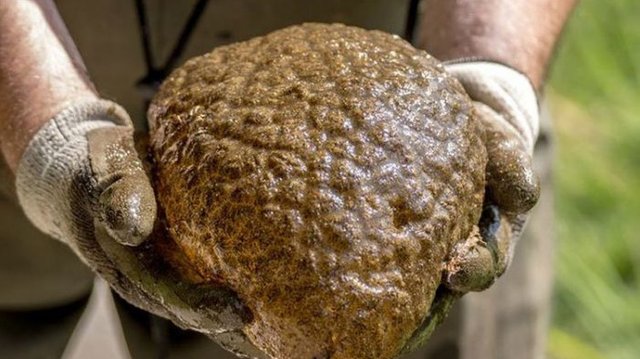
*sumber :Michael Schmid/SPES
Spesimen Pectinatella magnifica yang ditemukan di laguna buatan, Vancouver, Kanada. *
Para peneliti baru-baru ini menemukan makhluk aneh di sebuah laguna buatan di Vancouver, Kanada.
Mahluk tersebut memiliki tekstur lengket, licin, dan lembek, seperti jeli. Namun, yang menarik bukan hanya itu saja, tetapi penampakan bentuknya yang menyerupai otak manusia.
Makhluk aneh yang kemudian diketahui masuk kelompok bryozoa atau hewan invertebrata air ini berbentuk gumpalan dengan warna kehijauan.
Awalnya, para peneliti yang sedang melakukan ekspedisi biologi Bioblitz di Laguna Stanley Park di Vancouver Kanada tidak menyadari keberadaan mahluk ini.
Namun, air yang sedang surut akhirnya membuat gumpalan tersebut dengan mudah terlihat.
Makhluk yang bernama Pectinatella magnifica ini adalah satu organisme invertebrata tunggal, yang secara aseksual menghasilkan banyak klon dan disatukan dengan zat protein yang lengket.
Pectinatella magnifica sebenarnya masuk dalam kelompok bryozoa air yang sebagian besar tinggal di laut, tetapi P magnifica adalah sebuah pengecualian. Makhluk ini justru hidup di perairan tawar.
Menurut catatan fosil, kelompok bryozoa sudah hidup sejak 470 juta tahun yang lalu.
"Mereka memiliki silsilah kuno yang tidak berubah selama ratusan tahun," kata Kathleen Stormont dari Stanley Park Ecology Society (SPES) dikutip dari Science Alert 4 September 2017.
Migrasi
Bryozoa sebelumnya memang pernah terlihat di seluruh Amerika Utara, tetapi baru kali ini ia ditemukan di Stanley Park yang berada di Kanada.
Para peneliti memperkirakan bahwa spesies seperti Pectinatella magnifica berasal dari sungai Mississippi sebelum bermigrasi ke tempat lainnya.
Penyebaran ini terjadi melalui spora larva yang dibawa dari kolam ke kolam lainnya oleh bebek yang terbang atau angin.
Pectinatella magnifica memang tidak mudah ditemukan karena penampakannya. Orang akan terkecoh dan menyangka jika gumpalan itu tak lebih dari sebuah batu di dalam air atau kumpulan telur.
Dalam kasus ini, mereka baru terlihat karena kadar air di laguna lebih rendah dari biasanya.
Penampilannya yang lebih mirip otak ini sebenarnya hanyalah mekanisme pertahanan diri. Tidak berbahaya meski mungkin saat pertama kali melihat, kita akan merasa ketakutan.
Walaupun demikian, populasi Pectinatella magnificaperlu diwaspadai. Peningkatan yang berlebihan berpotensi menganggu keseimbangan ekologi ekosistem air tawar dan menyumbat pipa.
sumber:
(National Geographic,Science Alert)
In english :

*source :Michael Schmid/S
Specimens of Pectinatella magnifica are found in the artificial lagoon, Vancouver, Canada. *
Researchers recently found a strange creature in an artificial lagoon in Vancouver, Canada.
The creature has the texture of sticky, slippery, and mushy, like jelly. However, interesting is not only that, but the sighting of a shape that resembles the human brain.
A strange creature that was then known entered the group of bryozoans or animals invertebrates water this shaped blob with a greenish tint.
Initially, the researchers who are doing the expedition biology Bioblitz in the Lagoon Stanley Park in Vancouver Canada is not aware of the existence of these creatures.
However, the water was receding and finally make the blob is easily visible.
Creatures named Pectinatella magnifica this is one of the organism invertebrates, which asexually produce a lot of clones and put together with a protein substance that is sticky.
Pectinatella magnifica is actually in a group of bryozoans of water most of which live in the sea, but P magnifica is an exception. These creatures actually live in fresh waters.
According to the fossil record, a group of bryozoans has existed 470 million years ago.
"They have the ancient pedigree that has not changed for hundreds of years," said Kathleen Stormont from the Stanley Park Ecology Society (SPES) quoted from Science Alert 4 September 2017.
Migration
Bryozoans previously had never been seen in the whole of North America, but this is the first time he was found in Stanley Park which is located in Canada.
The researchers estimate that such species Pectinatella magnifica comes from the Mississippi river before migrating to other places.
This spread occurs through spores larvae brought from the pond to the other pond by the ducks are flying or the wind.
Pectinatella magnifica is indeed not easy to find because it looks. People will be fooled and think if the blob was nothing more than a stone in water or the collection of eggs.
In this case, their new looks because the levels of water in the lagoon is lower than usual.
His appearance is similar to the brain this is actually just a defense mechanism. Not dangerous although it may be the first time to see, we will feel fear.
Nevertheless, the population of Pectinatella magnificaperlu watch out for. Excessive increase potentially disturbing the ecological balance of freshwater ecosystems and clog the pipe.
source:
(National Geographic,Science Alerts)
Congratulations @syahruddin! You have completed some achievement on Steemit and have been rewarded with new badge(s) :
Click on any badge to view your own Board of Honor on SteemitBoard.
For more information about SteemitBoard, click here
If you no longer want to receive notifications, reply to this comment with the word
STOPDownvoting a post can decrease pending rewards and make it less visible. Common reasons:
Submit